65 F. average high for May 3.
.54" rain predicted for Thursday (NAM model).
70 F. possible Friday, better chance of 70 Saturday and Sunday.
April 10: last time the mercury surged past 70 in the Twin Cities (76 F).
Severe Storms: possible next Monday. It's only preliminary, but many of the factors will be present for what may be the first widespread severe storm outbreak of spring for parts of Minnesota.

Monday Severe Threat. We're due for a severe storm outbreak, and I have a (strong) hunch we may be tracking strong/severe T-storms across portions of Minnesota next Monday. Too early to get more specific than that, but know that Monday is one of those days you'll want to stay extra-alert to the sky, keep tuned to local media, and ask yourself "where would you go if threatening weather was heading my way?" No melodrama - but with all the crazy weather just to our south, the trends are ominous - at some point we may get a taste. Monday looks like the first chance of widespread watches/warnings.
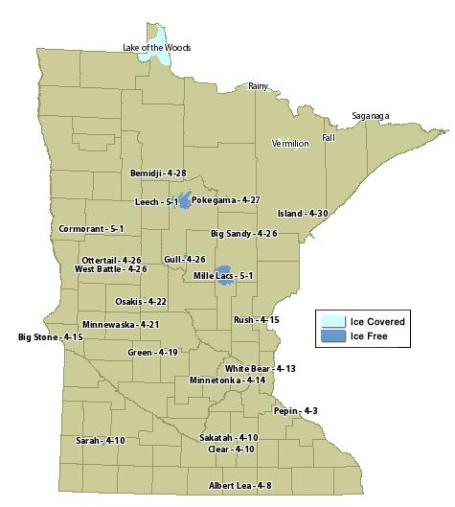
Minnesota Lake Ice-Out Status, Spring 2011. The Minnesota DNR has the very latest: "The ice out map here shows the ice cover status of selected lakes in Minnesota. Move your mouse over each lake for a bit more detail. For even more information, check the Minnesota Climatology Working Group Web page on Minnesota's Lake Ice-Out Status."
* As you can see the only lakes with ice are Rainy and Lake of the Woods. According to SCSU meteorologist D.J. Kayser Lake Mille Lacs lost all it's ice last Sunday, just 6 days away from the latest ice-out date on record!
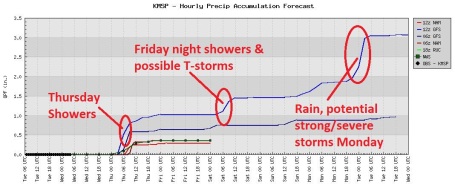
Best Chance of Rain? Showery rains are likely Thursday (probably not unstable enough for any widespread T-storms). Friday will be warmer, slightly more unstable, with a potential for showers and T-storms Friday night. I'm most concerned about Monday, when a warm frontal boundary, wind shear, instability and significant low-level moisture may result in the first (widespread) severe weather outbreak of spring for portions of Minnesota. Too early to get specific - but there's a risk.
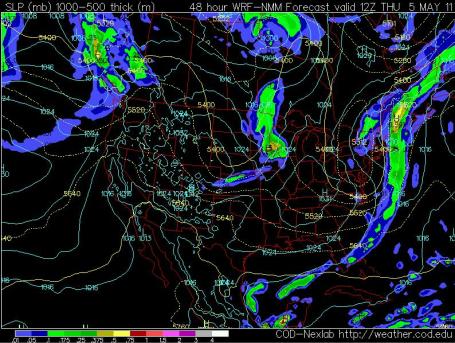
Thursday Showers. According to the NAM, GFS and GEMS models, the best chance of Thursday rain will probably come in the morning, but a straggling shower could spill over into the PM hours as well. That said, it probably won't ben an all-day rain. The atmosphere will be unstable, thunder is possible - but I don't think we'll have the dynamics for anything severe.

Saturday - "Partly Ugh". O.K. Not to panic - we're in a convective, showery pattern - Saturday doesn't look like a total wash-out, but expect a few hours of showers and possible thunder, best chance morning hours. If the sun peeks through and skies brighten by midday/afternoon (likely) the mercury may rise to 70, with a little more humidity in the air.
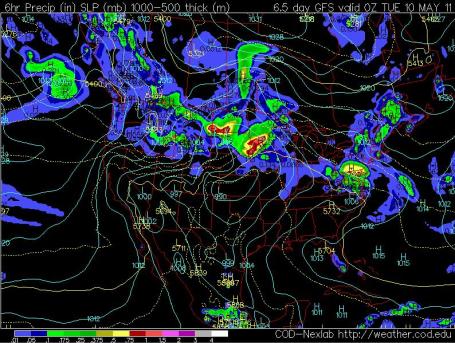
Monday Severe Threat? This is (far) from certain, but models lift a vigorous warm frontal boundary into far southern Minnesota by Monday afternoon, with enough potential instability, low-level warming and wind shear for a few severe thunderstorms by late afternoon or evening. I could see some watches/warnings late Monday into Monday night, depending on how far north that frontal boundary lifts. 113 tornadoes last year in Minnesota - we experienced more tornadoes than any other state in the nation. Will it be another above-average severe weather season? Count on it.
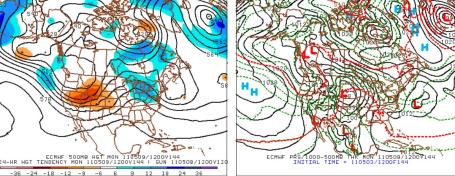
An Uneasy Feeling. Granted, any severe weather is 4-5 days away, and a lot can happen between now and then, but the ECMWF model valid 7 am Monday morning shows strong diffluence aloft, a vigorous warm frontal boundary surging into southern Minnesota, with enough potential instability and wind shear for a possible severe weather outbreak. We're due, and based on the trends, recent outbreaks from St. Louis to Alabama to North Carolina to upsstate New York, I wouldn't be surprised to see a few tornadoes close to home early next week. We'll see - hope I'm wrong on this one.
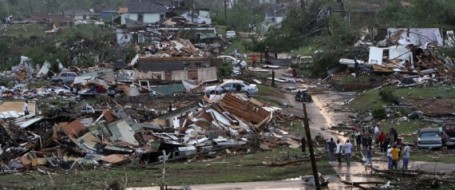
Alabama Taking Careful Toll Of Casualties From Storms. The story from the New York Times: "HAMILTON, Ala. — Nearly a week after the devastating outbreak of tornadoes, it is still not clear what the wind wrought. While the names of the dead have started to come out, adding a specificity to the grim count, the death toll continues to fluctuate by the day. According to the Alabama Emergency Management Agency, the death toll here in Marion County dropped by 12, for a new total of 23; the state’s overall toll dropped to 236 from 250. The agency is verifying and double-checking the number of deaths county by county, said Yasamie August, an agency spokeswoman. Ms. August said the state would not release an official death toll until that review was completed later in the week. Few are convinced that a final number has been reached or is even close at hand. “There are still people that ain’t been found,” said Doug Bryant, 38, of storm-ravaged Franklin County, Ala. Echoing a common sentiment here in Alabama, Mr. Bryant said of the death toll: “It’s low. It’s got to be.” Accurate information, like whether someone is missing, injured or dead, is still frustratingly difficult to come by in the worst-hit areas, which are affected with power failures."
* Media reports indicate that over 300 people (mostly in Alabama) are still listed as "missing". The death toll from last week's historic tornado outbreak stands at 340 - some of these people may still be found - alive, but officials worry the final death toll may exceed 500.
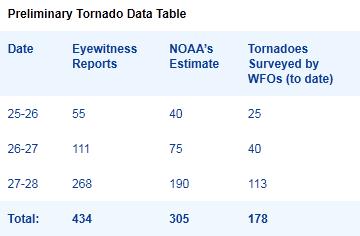
April 2011 Tornado Information. NOAA has a very good summary of last week's record-smashing tornado outbreak:
- The NWS Storm Prediction Center issued severe weather outlooks five days in advance and tornado watches hours in advance.
- NWS Weather Forecast Offices issued life-saving tornado warnings, with an average lead-time of 24 minutes. NWS issued warnings for more than 90 percent of these tornadoes.
- NWS decision support for this event has been extensive. NWS Weather Forecast Offices in the affected areas of Arkansas, Tennessee, Mississippi, Alabama and Georgia advertised the potential for severe weather in the Tuesday through Wednesday timeframe since late last week. Local offices provided direct decision support services to meet the specific needs of local emergency manager partners and the general public. NWS Weather Forecast Offices issued Hazardous Weather Outlooks up to six days in advance noting the greater threat of strong, long-track tornadoes was expected.
- The Tuscaloosa-Birmingham tornado during the April 2011 event caused at least 65 fatalities. This tornado had a maximum width of 1.5 miles and a track 80 miles long.
- These are the most fatalities from a single tornado in the United States since May 25, 1955, when 80 people were killed in a tornado in southern Kansas with 75 of those deaths in Udall, Kansas.
- The deadliest single tornado on record in the United States was the Tri-State tornado (Mo., Ill., Ind.) on March 18, 1925, when 695 died.
- EF5: 2
- EF4: 11
- EF3: 21

Alabama Schools Destroyed By Tornadoes. Making a sad situation all that worse, thousands of kids throughout Alabama have no schools to attend - they were destroyed by last Wednesday's outbreak, as reported by the Huffington Post: "HACKLEBURG, Ala. — Every morning since the beginning of the year, Hackleburg High School senior Wynn Knowles woke up thinking about his graduation. He already had a rough draft of his salutatorian speech in his head. Exactly one month before the biggest day of his life, he was helping his mom address invitations for graduation when one of the most powerful tornadoes Mother Nature can summon plowed through his town, destroying his home, his father's church and his school in a few ugly minutes last Wednesday. "Graduation and college are still going to be there. But they have moved way down the priority list," Knowles said. The tornadoes that raked Alabama last month heavily damaged 18 schools across the state, according to the Education Department. Some like Hackleburg's elementary and high school and three schools in Tuscaloosa are total losses. People in other small towns like Plainview and Phil Campbell are holding their breath hoping the centers of their small communities can be repaired. Soon enough, school officials will decide what to do about the final four weeks of the school year. But for now Hackleburg, a town of about 1,500 which lost more than two dozen people along with its fire department, police station, main employer and only grocery store too, is rallying around one of its most precious things, the school where about 550 of its children learn."
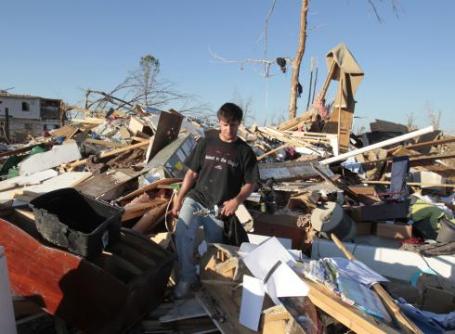
Three Members Of The Same Family Lose Homes In Tornado. Another tragic story from WFSA-TV, in Montgomery, Alabama: "Three members of one family in Elmore County all lost homes in the tornado. Jesse Sides is one of them. He's a former FEMA employee, who never expected he would need assistance. "I heard some big booms, I thought it was thunder, but it was a tornado going through out on the hill," Sides said. Sides ran into the hall closet, where his wife had been taking shelter from the storm. "We didn't know that the roof going off, it lasted for like five seconds," he said. "And then I felt air coming onto the door from the other room, and I told my wife. We're in trouble." When they left the closet, they found their home damaged, and large trees down all over the yard. Then he heard screams from the area where his sister lived. The tornado had destroyed their house. "We got to looking and found her and her husband under a bunch of rubble down under the hill," Sides said. "It was lucky they in a pocket and all the stuff was all on top of them, but they weren't hurt."
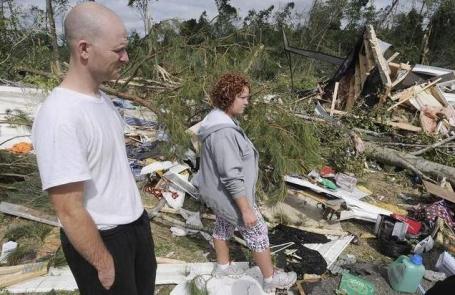
Tornadoes Damaged, Totaled 5,000 Homes. The Montgomery Advertiser has an update: "Last week's tornadoes destroyed or badly damaged 5,000 Alabama homes, according to information compiled by the American Red Cross. As of Sunday, the Red Cross had provided 3,556 overnight shelter stays to storm victims throughout Alabama and had given out 130,920 ready-to-eat meals, 1,650 blankets, 1,212 cots and 25,280 "comfort kits" that include personal hygiene items. In addition, the relief organization has 60 emergency response vehicles in damaged communities, said Red Cross spokeswoman Jackie Buck. Buck, who works in the Red Cross' Montgomery office, said she believes the organization has reached even the most remote areas of need in the state since Wednesday's tornadoes that killed more than 240 people."

Disaster Could Take An Emotional Toll On Survivors. Survivors of last week's massive tornado outbreak will suffer symptoms similar to what people living in New Orleans went through with "Katrina", what veterans returning from Iraq often grapple with: PSTD. Post traumatic stress disorder. They've been through a life-changing trauma, and a combination of medication and therapy will be required to help them get their coping skills back. But many of these people will suffer emotional and even physical symptoms, especially when skies darken and the next line of severe thunderstorms rumbles across the Deep South. Here is a story from WTVA-TV: "The tornadoes that hit North Mississippi Wednesday has caused untold physical devastation to hundreds of people. It has flattened much of the city of Smithville, and left hundreds injured, and over a dozen dead. The psychological effects of the disaster may be just as devastating."This is not a short term fix. Three or four weeks of intense effort on the part of FEMA or anyone else for that matter, is (not) going to touch this," said Neuropsychologist Samuel Fleming, III. Dr. Fleming has counseled victims of Hurricane Katrina. He said, more often than not, those who saw or experienced the most severe trauma in the wake of the tornadoes may suffer from Post Traumatic Stress Disorder. Some of the symptoms of PTSD is insomnia, restless sleep, depression, fear, exhaustion and flashbacks. "They will have a flashback as though they were experiencing the tornado all over again. It's (reliving the disaster) a double whammy. Not only are they (survivors) going through it (the disaster) once, but now they are going through it (the disaster) a second time (in their mind)," said Dr. Fleming."
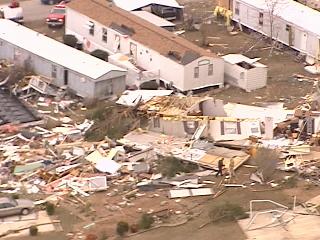
In Tornado Zones, Seeking Shelter From The Storms. Andy Revkin at the New York Times takes a look at climate change, frequency and intensity of killer tornadoes, and building standards in the Deep South. It's a rather convoluted argument, but in the spirit of full disclosure, here is his post: "But, first a brief diversion. Given continued assertions that human-driven global warming could be playing a role in the havoc down south, it’s also worth revisiting something that Walker S. Ashley, a meteorologist at Northern Illinois University, said last week on Dot Earth: "The heart of the matter lies with a growing and increasingly vulnerable population. That is what is driving “disasters.” There’s no doubt that Michael Mann of Pennsylvania State University is right when he says “climate change is present in every single meteorological event” — in the sense that the buildup of greenhouses gases is a background nudge everywhere. But that’s a meaningless assertion without asking whether there is evidence of a meaningful influence — meaning enough of a nudge to the atmosphere that the contribution from greenhouse gases is relevant to policy and personal choices, in this case in tornado zones. For the moment, there’s scant evidence to support this at any level — in the basic data on storm patterns or in tallies of damage and deaths. I’m not denying it’s possible, just that it’s relevant. It’s fine for Kevin Trenberth of the National Center for Atmospheric Research to say he feels “it is irresponsible not to mention climate change” when discussing tornado outbreaks. Everyone’s entitled to his or her view. My response would be that it is irresponsible not to mention the need to reduce inherent and avoidable human vulnerability to tornadoes in the crowding South, particularly in low-income regions with flimsy housing. I saw barely a mention of these realities in recent posts by climate-oriented bloggers on the tornado outbreak."
UPDATE: It is unfortunate that NYT blogger Andy Revkin has chosen to inappropriately shorten and then take out of context the nuanced statements of a number of actual scientific experts, like Trenberth. Ironically, Revkin supports a too-little, too-late energy technology development strategy for dealing with climate that not only can’t possibly avert catastrophic global warming but it can’t even generate funds needed for climate adaptation. So it is hypocritical of him to attack others for not constantly saying how much we need to improve housing for those in tornado alley. Obviously we do, and that’s a great thing for blogs that don’t focus on climate to write about at length. Just as obviously we need an aggressive strategy for reducing GHGs that also supports real adaptation.
Joseph Romm
Senior Fellow, Center for American Progress/ Editor, ClimateProgress.org

Deadly Tornado Strikes Auckland. Killer tornadoes in New Zealand? Very odd, and extremely rare. At least one local resident was killed by flying debris from the freak tornado touchdown. Stuff.co.nz has the details and some amazing video: "Stunned shoppers wandered amid cars lying on their sides, pieces of corrugated roofing twisted around them, and trees torn from their roots by a tornado that tore through Auckland. The twister left at least one person dead and more than 20 adults and children in hospital, one with serious injuries. Police said a middle-aged man died in an ambulance on the way to hospital, and an Auckland Hospital spokesperson said a 30-year-old man was in a serious but stable condition last night. St John Ambulance regional operations manager Murray Holt said his officers arrived in Albany, 15 kilometres northwest of Auckland city, to find a "chaotic" scene of overturned cars and critically injured people after the tornado hit about 3pm. "We've had a number of people with deep cuts, head injuries; flying debris – and when we say flying debris, we've had cars picked up and tossed across the car park. "We've got cars that have been overturned, roofing iron flying around, and a shed picked up and thrown across the car park. "People were shocked by the suddenness with which it occurred and the ferocity. It was gone as quickly as it arrived, so people were just absolutely bewildered." Witness Julie Carter described seeing a white car thrown through the air with three children inside it at the Albany Mega Centre."
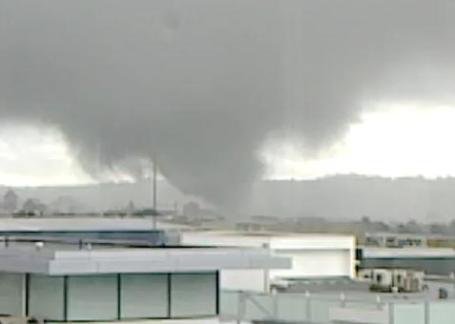
Another Perspective. Here's a YouTube clip of the same Auckland, New Zealand tornado, which appears to be an EF-1 or EF-2, winds probably well over 100 mph.

Waterspouts In Hawaii. This YouTube footage was shot on the island of Oahu. Yes, it's a bit unusual for Hawaii.
* Another YouTube clip of the waterspout is here. Local residents say it's the first time a tornado/waterspout has been observed over Oahu.
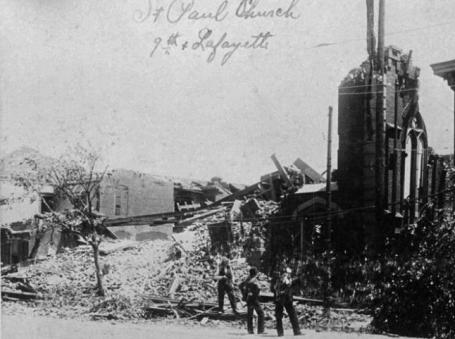
The Long War Against Deadly Tornadoes. Up until 1952 it was illegal for meteorologists to use the term "tornado", for fear of inciting public panic, which "could be worse than the storm itself." Today that edict looks ridiculous, but there was real fear that mentioning the T-word might result in chaos, confusion and throw the population into a frenzy. NPR has an excellent story about the history of tornado prediction: "The recent tornadic destruction and loss of lives across the United States echoes another era more than 100 years ago — a time when humans began trying to outwit and even defeat tornadoes. In the 1880s, American newspapers were peppered with reports of deadly tornadoes all across the nation. Nearly 100 people were killed by a storm in south Missouri. Another 22 died in a Mississippi disaster. Forty more were killed in Texas and Iowa. More than 300 died from tornadoes in 1882. And in 1884, the New York Times reported, an unparalleled series of tornado-laden storms cut across eight states — Illinois, Kentucky, Mississippi, Georgia, Tennessee, Virginia, North Carolina and South Carolina — at the same time. Some 800 people were killed, 2,500 injured and 10,000 buildings were razed. Over the next 20 years, several enterprising people devised large-scale schemes to thwart tornadoes in their paths. Apparently, none of them worked. But the intense national focus on the treacherous characteristics of tornadoes eventually led to a greater understanding of the natural forces — and greater respect for and appreciation of their powerful malevolence."

Flood Potential In Memphis. Flooding in the Memphis area is predicted to reach record levels in the coming days. Here is a pdf showing the predicted area of flooding in the city and suburbs.
Flood Update. The Army Corps of Engineers has blown up the levee in Southeast Missouri, allowing flood waters to inundate substantial portions of two counties in Southeast Missouri.
However, the opening of the flood-way has had the intended effect, with the river level at the city of Cairo IL lowered dramatically, with the river level at Cairo down a full foot in just the past six hours.
( pretty dramatic shot of the explosion )
* Thanks to James Aman from Earth Networks for passing this along.

Saved By Dynamite. The Army Corp of Engineers dynamited the levee near Cairo, Illinois, saving the town, but inundating tens of thousands of square miles of farmland nearby in the process. Which brings up an important moral/ethical dilemma: better to save the town, or the hundreds of farmers nearby? Two bad options. See the river gauge data for yourself here.

Army Corp Blows Levee To Help Fight Unprecedented Mississippi River Flooding. A unique perspective (as always) from Dr. Jeff Masters and his Wunderblog: "A brilliant string of explosions rippled across a two-mile length of the Mississippi River levee at Birds Point, Missouri at 10pm last night. As the levee disintegrated, a 4-story high cascade of muddy brown water from the Father of Waters gushed into the crevasse, thundering with the flow of eight Niagara Falls. The waters quickly spread out over 133,000 acres of rich farmland, rushing southwards along the 35-mile long Birds Point-New Madrid Spillway. The levee that was destroyed--called a plug fuse levee--was designed to be destroyed in the event of a record flood. In a marathon 20-hour operation, 150 engineers from the Army Corps of Engineers packed 22 wells in the levee with explosives on Sunday and Monday. A raging thunderstorm with dangerous lightning halted the work for a time on Sunday night, as the engineers were pulled off the levee due to concerns about lightning. Final approval for the demolition occurred after a series of failed court challenges, brought by the Attorney General of Missouri, ended at the Supreme Court on Monday. Damage to the farmland and structures along the the Birds Point-New Madrid Spillway is estimated to cost $317 million due to the intentional breach of the levee. The fact that the Army Corps is intentionally causing 1/3 of billion dollars in damage is stark evidence of just how serious this flood is. The Birds Point levee has been demolished only once before, during the historic 1937 flood."

Historical Mississippi And Ohio River Flooding. Convectiveaddiction.com has a story about a slow-motion disaster that is creeping up on us: some of the worst flooding since 1927: "While much of the focus in the chasing community remains squarely focused on the historical tornado outbreak across the south, and rightly so, there is another major weather event underway. The slow rise of the river along the middle and lower river valleys will create crests that haven’t been reached since at least the early 20th century."

Heat Wave Sees Warmest U.K. April For More Than 100 Years. The BBC has the latest: "Last month was the UK's warmest April on record, the Met Office has said. The records, which go back more than 100 years, show much of the UK experienced temperatures 3 to 5C warmer than is normal for April. It was also the 11th driest month, with on average half the usual rainfall. But there was also great variation in the amount of rain. Parts of north-west Scotland saw about 110% of normal April rainfall, while parts of south-east England saw less than 10% of normal. The UK average temperature was 10.7C, exceeding the previous warmest April on record of 10.2C in 2007. Following a drier-than-average winter, the dry April followed a dry March which saw less than half of the normal rainfall falling across the UK."
America's Only Winter Weather Advisory (in Hawaii!)
URGENT - WINTER WEATHER MESSAGE
NATIONAL WEATHER SERVICE HONOLULU HI
350 PM HST MON MAY 2 2011
...ICY AND SNOWY ROADS LIKELY ON MAUNA KEA AND MAUNA LOA SUMMITS...
.SNOW AND FREEZING DRIZZLE AND FOG WILL CREATE HAZARDOUS DRIVING
CONDITIONS ON THE BIG ISLAND SUMMITS....WINTER WEATHER ADVISORY REMAINS IN EFFECT UNTIL 6 AM HST
TUESDAY...A WINTER WEATHER ADVISORY REMAINS IN EFFECT UNTIL 6 AM HST
TUESDAY. SCATTERED SNOW SHOWERS AND AREAS OF FREEZING DRIZZLE AND FOG WILL
LEAD TO ICY CONDITIONS ON SUMMIT ROADS. SNOW ACCUMULATIONS OF 1 TO
3 INCHES ARE POSSIBLE.
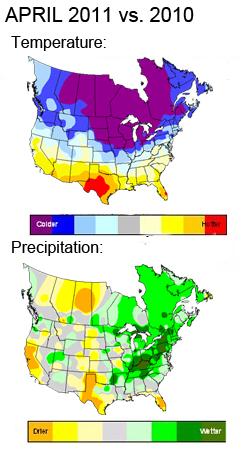
April Comparison. The Weather analytics firm, Planalytics, has a summary of April 2011 vs. 2010:
"While April 2011 was warmer than normal, it was still cooler than April 2010, which was the 2nd warmest in the last 50 years. Precipitation across North America was the most in 20 years. The U.S. had its 11th warmest April in 51 years and it was the wettest since 1991. Canada was cooler than normal and had its wettest April in 15 years" Significant Weather Events: - Over 600 tornados were reported in the month of April breaking the previous record of 267 set in 1974. April 2011 had the most severe weather events in the past 10 years with over 6,000 events reported.
- Flooding remained a high concern throughout the entire month along the Red River, Mississippi and Ohio River Valleys driven by record precipitation.
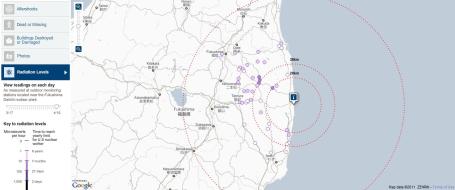
Drumbeat Of Nuclear Fallout Fear Doesn't Resonate With Experts. An interactive story from the New York Times: "The nuclear disaster in Japan has sent waves of radiation and dread around the globe, prompting so many people to buy radiation detectors and potassium iodide to fend off thyroid cancer that supplies quickly sold out. The fear is unwarranted, experts say. People in Japan near the Fukushima Daiichi nuclear power plant may have reason to worry about the consequences of radiation leaks, scientists say, and some reactor workers, in particular, may suffer illness. But outside of Japan, the increase is tiny, compared with numerous other sources of radiation, past and present. Experts say that humans are bombarded by so much radiation from so many other sources, including many natural ones, that the uptick from Japan disappears as a cause of concern the big picture is considered."

Rejecting Wall Street, Business School Graduates Turn To Entrepreneurship. Here's evidence of a new trend, from the New York Time's Dealbook: "Kimball Thomas and Davis Smith, co-founders of the e-commerce site Baby.com.br, had just six hours in Brazil to pitch to prospective investors and recruit a promising executive for the chief operating officer role. With little time left after a four-hour meeting with Monashees Capital, the prospective candidate, In Hsieh, agreed to drive the entrepreneurs back to the airport for his interview, braving the city’s notoriously congested roads as he answered their questions. Mr. Thomas and Mr. Smith, who are cousins, made their evening flight, and Mr. Smith got home in time for his final exam at business school. “Between my redeye flights, I didn’t have time to study,” Mr. Smith said. “But I realized, the whole reason I went back to school was to build a business like this.” Mr. Smith, who attends the Wharton School of the University of Pennsylvania, and Mr. Thomas, of Harvard Business School, are part of a growing number of business school students rejecting traditional postgraduate paths like investment banking, hedge funds and consulting. It’s a trend that is accelerating in the wake of the financial crisis as Wall Street loses its luster and Silicon Valley shines with a new crop of multibillion-dollar start-ups."

Julian Assange: Facebook Is "Appalling Spy Machine." Not sure how much credibility this guy, the force behind "Wilileaks" has left, but his comments about Facebook are kicking up some Internet-dirt. Huffington Post has the story: "In an interview with Russia Today (RT), Julian Assange called Facebook the "most appalling spying machine that has ever been invented." He told RT's Laura Emmett, "Here we have the world's most comprehensive database about people, their relationships, their names, their addresses, their locations, their communications with each other, their relatives, all sitting within the United States, all accessible to U.S. intelligence." It's not new ground for the Wikileaks founder. In March, Assange told Cambridge University students that the Internet is "the greatest spying machine the world has ever seen." During the Russia Today interview, Assange explained that Facebook, Google and Yahoo all provide automated interfaces for the U.S. intelligence (starts around 2:00 in the video below). "When they add their friends to Facebook," Assange said, "they are doing free work for United States intelligence agencies." Unlike The Onion's prescient fake news piece that poked fun at Facebook's success as a CIA program earlier this year, Assange says that these Web sites aren't being run by the government. Instead, the intelligence community is able to "bring to bear legal and political pressure to them."

Who Shot Bin Laden? Former Navy Seals Fill In The Blanks. Some additional detail from this story in the Washington Post: "Chances are he’s keeping score. Smith, who served in the SEALs from 1991 to 1999, got together recently with five Navy SEALs, some of whom he’d served with and others whom he’d trained. “They were responsible for 250 dead terrorists,” Smith says. “They know their number.” But there are terrorists, and then there are TERRORISTS. Bin Laden falls into the latter category. It’s hard to imagine someone not wanting to take credit for such a significant kill. Yet revealing SEALs’ identities would make them targets for al-Qaeda sympathizers and would also make it difficult or impossible for them to participate in future secret operations.
The identities of other key players in the war against terrorism remain anonymous. No one has identified the troops who slapped cuffs on Iraqi dictator Saddam Hussein or named the pilots who dropped the bombs that killed Abu Musab al-Zarqawi, head of al-Qaeda in Iraq. Times have certainly changed. Another era’s military history-makers were frequently publicly identified — Paul Tibbets, the pilot of the Enola Gay, the plane that dropped a nuclear bomb on Hiroshima, wasn’t a mystery. But this is a different kind of war — a kind of perpetual, amorphous conflict — one much less likely to see a formal declaration of peace. Also it’s likely the shooter’s superiors would forbid him and his colleagues to reveal his identity."

Turning To Social Networks For News. Speaking of trends, is there (really) a better way to follow breaking news than Twitter? Who you "follow" on Twitter is everything, but if you want a real-time stream of information (some nuggets more reliable/vetted than others) Twitter is the new model, as reported by the New York Times: "When the White House abruptly announced an address to the nation by President Obama on Sunday night, CNN anchors spent the better part of an hour previewing the address without actually saying what it was about. “I have my own gut instincts on what it might be,” the CNN anchor Wolf Blitzer said a couple of times, adding that a senior White House official had thanked him for showing “restraint” and not speculating. Thanks to Twitter and Facebook, some CNN watchers had already heard the news. Unconfirmed reports — that turned out to be true — of Osama bin Laden’s demise circulated widely on social media for about 20 minutes before the anchors of the major broadcast and cable networks reported news of the raid at 10:45 p.m., about an hour before Mr. Obama’s address from the White House. It was another example of how social media and traditional media deal with the same news in different ways and at different speeds. Just as CNN once challenged newspapers and evening newscasts with a constant stream of images from the Persian Gulf war, Twitter and Facebook have become early warning systems for breaking news — albeit not always reliable ones. Twitter saw the highest sustained rate of posts ever, with an average of 3,440 per second from 10:45 p.m. to 12:30 a.m. Eastern time. There were more than five million mentions of Bin Laden on Facebook in the United States alone, as news of the raid at his hideout spread starting around 10:30 p.m. A new Facebook page titled “Osama bin Laden Is Dead” popped up for people to begin sharing their thoughts. It had more than 400,000 fans on Monday. (A second page, “Osama bin Laden Is Not Dead,” soon followed.)"


On The Right Track. Tuesday was a sight for sore (slightly frost-bitten) eyes: bright blue skies, light winds, a beautiful May day. Highs ranged from a chilly 44 at Grand Marais to 59 in St. Cloud and the Twin Cities, to 61 at International Falls.

Paul's Conservation Minnesota Outlook for the Twin Cities and all of Minnesota:
TODAY: Mild sun, more wind. Clouds increase this afternoon/evening. Winds: S 15-25. High: 63
WEDNESDAY NIGHT: Showers develop, possible thunder. Low: 46
THURSDAY: Showery rains, unsettled. A stray T-shower can't be ruled out. High: near 60
FRIDAY: Skies brighten, dry & milder. Low: 47. High: 69
SATURDAY: Mild, passing shower, T-storm. Skies brighten from time to time (not an all-day rain). Low: 51. High: 70
SUNDAY: Few spotty showers, possible thunder. Peeks of sun expected. Low: 52. High: 71
MONDAY: Heavier rain, few strong to severe T-storms? Low: 57. High: 73
TUESDAY: Slightly cooler, passing shower. Clouds linger much of the day. Low: 56. High: 68

Weather Trauma
Here's a dirty little secret: most TV meteorologists got their start due to a traumatic weather event in their childhood: a tornado, flood, hurricane or blizzard. Something put the fear of God into them, and trying to make sense of their "close encounter" ultimately led to a career in meteorology. Nobody in their right mind wakes up and thinks, "I want to humiliate myself in public every other night for a living!" For me it was Tropical Storm Agnes, which stalled over Pennsylvania in 1972; turned out basement into an Olympic-size swimming pool.
America experiences more severe weather than any other country; we are a nation of armchair meteorologists, and for good reason. Tornado survivors in Alabama are suffering from PTSD, Post Traumatic Stress Disorder. Symptoms include insomnia, depression, fear and flashbacks. Every time a storm approaches their hearts will race, sweaty palms, an overwhelming feeling of dread. Therapy can help, but it may take years to recover.
Sun fades today, .34" rain predicted on Thursday. Showers are likely this weekend (no all-day rains), heavier rain (and a few strong to severe T-storms) Monday. Models are hinting at 70 F. by this weekend. Yes please.

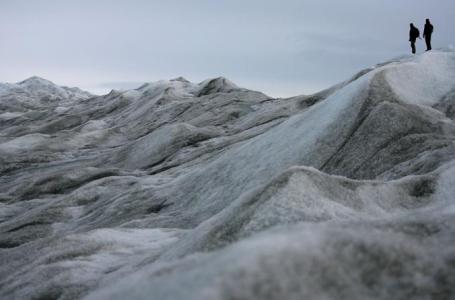
Arctic Ice Melt "Alarming". What first struck me about this article was the accompanying photo (above), the sheer amount of soot (black carbon) on the ice in Greenland. This impacts albedo - darker surface absorb more sunlight, accelerating warming (and melting of ice). One of those "positive feedbacks" we hear so much about that tend to alarm climate scientists. Here's an excerpt: "Ice in Greenland and the rest of the Arctic is melting dramatically faster than was earlier projected and could raise global sea levels by as much as 1.6 metres by 2100, says a new study. The study released on Tuesday by the Arctic Monitoring and Assessment Program (AMAP) said there is a "need for greater urgency" in fighting global warming as record temperatures have led to the increased rate of melting. The AMAP report said the correspondending rise in water levels will directly threaten low-lying coastal areas such as Florida and Bangladesh, but would also affect islands and cities from London to Shanghai. The report says it will also increase the cost of rebuilding tsunami barriers in Japan. "The past six years (until 2010) have been the warmest period ever recorded in the Arctic," said the report. "In the future, global sea level is projected to rise by 0.9 metres to 1.6 metres by 2100 and the loss of ice from Arctic glaciers, ice caps and the Greenland ice sheet will make a substantial contribution," it added. The rises had been projected from levels recorded in 1990. Dramatic rise from projections: In its last major study in 2007, the United Nations' Intergovernmental Panel on Climate Change (IPCC) said that sea levels were likely to rise by only between 18 and 59 centimetres by 2100, though those numbers did not include any possible acceleration due to a thaw in the polar regions. The new AMAP assessment says that Greenland lost ice in the 2004-2009 period four times faster than it did between 1995-2000."

Study: Warming Won't Lessen Wind Energy. UPI's Science News has the story: "BLOOMINGTON, Ind., May 2 (UPI) -- Climate models of wind patterns suggest U.S. wind energy production over the next 30-50 years will be largely unaffected by global warming, researchers say. Indiana University scientists in Bloomington have completed the first analysis of long-term stability of wind patterns in America's lower 48 states, an IU release reported Monday. "The greatest consistencies in wind density we found were over the Great Plains, which are already being used to harness wind, and over the Great Lakes, which the U.S. and Canada are looking at right now," Sara Pryor, a professor of atmospheric science, said. "Areas where the [warming] model predicts decreases in wind density are quite limited, and many of the areas where wind density is predicted to decrease are off limits for wind farms anyway." Scientists have long pondered whether a warmer atmosphere might lead to decreases in wind density or changes in wind patterns.

If Global Warming Is Inevitable, Relax and Observe It. Just give up? A lot of otherwise logical, reasonable people are now saying it's inevitable that "we will have to adapt" - there's little we can do to stop the warming already loaded into the atmosphere. Here's one perspective from Robert Brown at Seattle PI: "I can’t say ‘enjoy it’, since I have children and g-kids who might find it difficult. But from an Atmospheric Scientist standpoint, I’m looking forward to observing the data. It will be satisfying to see the model predictions evolve; relief if they don’t. It will become obvious. We understand the “natural” cycles; the diurnal cycle (the earth’s a spinning ball), the annual cycle (earth’s orbit and tilt angle determine it), the Milankovich cycle (perturbations in the orbit and tilt determine the glacial/interglacial 100,000-year cycle), the El Nino/La Nina cycle(at least partly), and the sunspot cycle (11-years, tho it comes and goes in maybe 50-year cycles; we do know the relatively small amount of radiation change — and it’s at a minimum/cold about now.) And we understand a lot about the new perturbation — record breaking CO2 increases bearing the fingerprint of fossil fuel consumption with its effect as a greenhouse gas (At. Sci 101); and the consequent warming and changes in storms, ice distribution, ocean acidification, etc. We have mathematical models that have done well in reproducing long-term observed global climate when initialized with observed data, and tell us what to expect as present data (including increased CO2) is used as input. We have good global temperature and CO2 measurements, so we’ll soon know (10-years? — very soon for a geophysicist)."
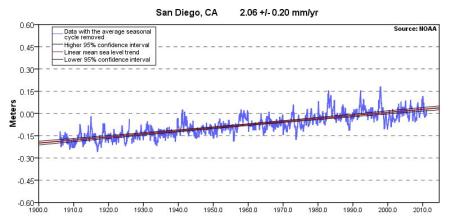
No comments:
Post a Comment